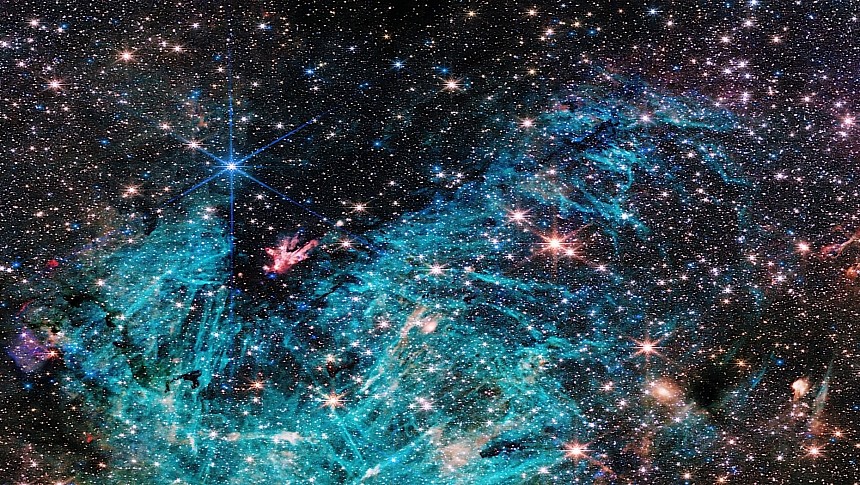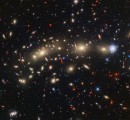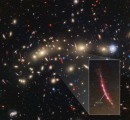It's impossible to know such things for sure, but estimates point to around 200 billion trillion stars being alive and kicking in our Universe today. That is if you consider our own Milky Way and its 100 billion suns as a standard of universal star formation and evolution. And guess what, this single image shows half a million of those stars, all clustered together at the center of our galaxy.
The image you're looking at now is the latest captured by the James Webb Space Telescope, "the largest, most powerful telescope ever launched into space." The thing was pointed at a region of space located just 300 light years from the supermassive black hole known as Sagittarius A and located at the center of the Milky Way.
The place you're looking at is called Sagittarius C, and it is more or less a nursery for young stars. It's seen here in what astronomers describe as being unprecedented detail, down to protostars – that would be suns that are still forming and gaining mass.
You might find it a bit tricky to spot what's what in this incredible mass of light and darkness, so the European Space Agency, who made the pick public, explained it to us based on the colors and other elements shown here.
The "outflows that glow like a bonfire in the midst of an infrared-dark cloud," for instance, are in fact the protostars I mentioned earlier, all clustered together. They are all crammed around a massive celestial body 30 times the mass of our own Sun, and hidden behind a cloud of gas so dense not even their light can escape it to reach Webb.
The infrared-dark clouds in the image, on the other hand, the ones that look like holes in the starfield, show the places where new stars are forming.
The cyan colors in the pic reveal large-scale emission from ionized hydrogen, and that in turn is “the result of energetic photons being emitted by young massive stars." That's something we've known to happen out in the darkness of space, but there is one surprise about this thing that has astronomers baffled and scrambling to learn more: the vastness of the region that contains this ionized hydrogen.
Webb has also spotted in the center of our galaxy's clouds of hydrogen needle-like structures, something that has never before been seen. These things, which appear to be oriented in a chaotic manner in all directions, are yet to be explained, but will form the target of astronomer's attention in the months ahead.
Before we get to learn more about what the upcoming studies will reveal about our own galaxy's center, keep in mind the image you're looking at shows a place located 25,000 light-years from Earth. That's 146,643,601,368,010,800 miles or 236,000,000,000,000,000 km away. Mind-boggling, right?
The place you're looking at is called Sagittarius C, and it is more or less a nursery for young stars. It's seen here in what astronomers describe as being unprecedented detail, down to protostars – that would be suns that are still forming and gaining mass.
You might find it a bit tricky to spot what's what in this incredible mass of light and darkness, so the European Space Agency, who made the pick public, explained it to us based on the colors and other elements shown here.
The "outflows that glow like a bonfire in the midst of an infrared-dark cloud," for instance, are in fact the protostars I mentioned earlier, all clustered together. They are all crammed around a massive celestial body 30 times the mass of our own Sun, and hidden behind a cloud of gas so dense not even their light can escape it to reach Webb.
The infrared-dark clouds in the image, on the other hand, the ones that look like holes in the starfield, show the places where new stars are forming.
The cyan colors in the pic reveal large-scale emission from ionized hydrogen, and that in turn is “the result of energetic photons being emitted by young massive stars." That's something we've known to happen out in the darkness of space, but there is one surprise about this thing that has astronomers baffled and scrambling to learn more: the vastness of the region that contains this ionized hydrogen.
Webb has also spotted in the center of our galaxy's clouds of hydrogen needle-like structures, something that has never before been seen. These things, which appear to be oriented in a chaotic manner in all directions, are yet to be explained, but will form the target of astronomer's attention in the months ahead.
Before we get to learn more about what the upcoming studies will reveal about our own galaxy's center, keep in mind the image you're looking at shows a place located 25,000 light-years from Earth. That's 146,643,601,368,010,800 miles or 236,000,000,000,000,000 km away. Mind-boggling, right?





